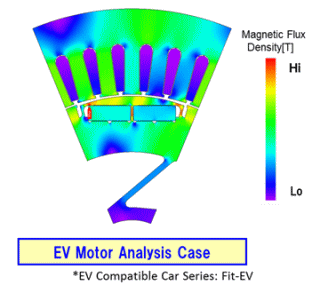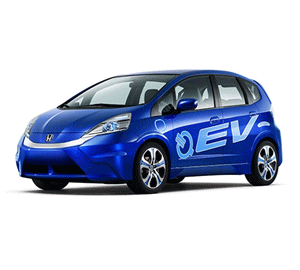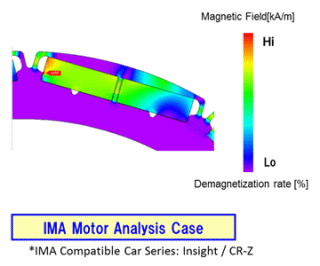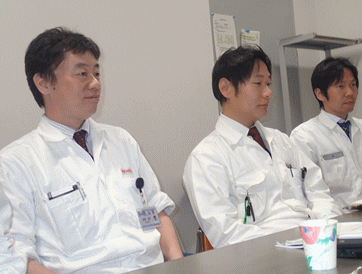Employing JMAG as the Common Language of Motor Development Devise Unique Solutions and Accelerate Creative Development

It’s no exaggeration to state that eco-friendly hybrid and electric vehicle development will determine who comes out on top of the automobile industry this century. The core component of the vehicle is the motor, and Honda R&D leads the field in ingenious motor development.
JMAG serves as a “common tongue” for the magnetic circuits of motors and contributes to inspiring Honda’s creativity.
We discussed JMAG with Mr. Kaizuka, the motor development group leader and staff for Automobile R&D Center Technology Development Division 5.
Bestowing the fundamentals of vehicle creation with “bullseye” precision
Kaizuka:
We develop electric power plants for hybrid electric vehicles (HEV), electric vehicles (EV), plug-in hybrid electric vehicles (PHEV) and fuel cell vehicles (FVC). To be exact, we work on motors, batteries, and inverters. Of all of these, we are primarily concerned with motor development and research. There are members of our team who work on development geared for mass production, and other members in charge of elemental technology with an eye on the future.
Kaizuka:
Our hybrid system equipped with FIT is characterized by a relatively moderately-priced motor with high environmental performance. Power is drawn from the motor when accelerating, while performing the regenerative power generation with the same motor when decelerating. Two separate motors aren’t needed for both acceleration and regenerative power generation, so just installing relatively low volume specialized secondary batteries works.
Furthermore, this allows for a light, compact design, so one of the merits is that this system can be used in a wide variety of vehicles. Motors are being manufactured internally based on these technological achievements, but if the development and design for the motors can’t keep up with commercial production, the damage will be large. The requirements for development are extremely demanding; from the development stage to the start of production, not even a second’s delay can be tolerated. JMAG is an essential tool for development and planning, as it can be used in these strict conditions.
Kaizuka:
It is considered normal that calculation results of torque, torque ripple, loss, and power match the measured values. With a background like that, JMAG is used to inspect various tasks in order to reduce the number of prototypes and realize high precision analysis from the initial stages of development. In other words, calculating something without actually physically creating it, and then correctly making that item based on those calculated results is what we mean by “bullseye” precision, which is our goal. Not all motors can be made creating only one prototype with JMAG, but we still strive to hit the bullseye, so to speak.
Regarding how to use JMAG, our company has its own specialized uses, and this is shared amongst JMAG users. For example, with our unique modeling methods, instructions for usage, and discovering issues in our products under development, we are able to come up with unique ways of using JMAG for analysis, and we are proud to say that we have enabled JMAG to be used as an essential tool for motor development. Currently we are delving in even further by working on analyzing motor noise and heat with high accuracy.
Overcoming requirements with JMAG
Kawanami:
I work on EV and FCV motor development. For EV motors, there are several technological requirements for vehicles, such as implementing an efficient motor with high power performance to guarantee range as well as power performance and technological maturity. Especially in the area of efficiency, EV and FCV are vehicles ran by motors, so heating and cooling performance is an utmost requirement. To create a design with a high accuracy heat calculation, heat generation and its areas must be well known. We calculate loss distribution calculations in magnetic field simulation by using JMAG’s finite element method, and then perform a thermal analysis based on the obtained results.
Kawanami:
Only the type of fuel for EV and FCV is different, so as motors there is no difference. In any case, motor development for EV and FCV clearly shows the difference of technological competence from other companies. Motor efficiency is connected to electric efficiency and how the car feels when running. Magnet demagnetization in the motor is especially a big issue. JMAG is invaluable in taking design to its very limit and determining exactly where demagnetization is occurring.


Soma:
I work on one-motor hybrid vehicles such as “FIT” and “VEZEL”. For one-motor vehicles, their motors require a high torque density.
We want to make the installation space as small as possible, so we have put our utmost efforts into the size and geometry of the motor. Space between neighboring parts is also very tight, so heat-related requirements are also demanding. On other hand, as the amount of hybrid vehicles increase, so does volume efficiency, so I want to create designs that can cut costs by even one yen. For stringent design requirements, we use JMAG on a daily basis.


Inoue:
I am participating in the development of two-motor vehicles such as “Accord PHEV.” Although it has two motors, it does not necessarily mean that there are two times the employees involved, but there is still a need to reduce development time, and this is made possible using JMAG. The software comes in handy when pinpointing exactly what it is that needs focusing in the development stage. The process involves a wide range of parameters for evaluation to suit various situations. We then need to assess the problems, find solutions and tie it into production. As a lot of weight is on thermal analysis, we make frequent use of it in JMAG.
Highly reputed as “trustworthy because its results are derived from thorough analyses.”
Kaizuka:
We obviously started motor development to develop electric motor cars and I believe this was at the start of the 90s. Conventional cars also equipped various types of motors but the motors for electric motor cars were completely different. However, we had absolutely no knowledge of motor design or magnetic field analysis to the level of “what kind of motor do we need to make, and how much torque can we expect from it.”
As we accumulated knowledge, we incorporated magnetic field analysis software and was finally able to deliver our first motor, but the software we were using had difficulty in working with large models and analysis time took too long to meet our demands.
Kaizuka:
That’s right. We began with only a few licenses of JMAG, but we were satisfied with the results that exceeded our expectations such as its usability, high accuracy, wide analysis range and helpful support team. JMAG users gradually increased within the company, and now most departments make full use of the software.

Iki:
I am responsible for the future of element technology. I use optimization calculation in designing more than a thousand patterns to research motor characteristics in response to various conditions. For this reason, designs evaluated with JMAG are said to be “highly trustworthy in design as it has been throughly evaluated in the analysis.”
Oya:
I am in charge of two regions including new generation motors and one-motor types. This includes finding the point where conditions and demands intersect. I narrow down ideal conditions from these limited design spaces. Instead of “let’s just make it and see what happens,” we start production using only one specification based on JMAG’s analysis results. JMAG’s analysis results always delivers the output that we had in mind.
Iki:
Even for themes that are extremely complicated, JMAG would prove to be a lot of help. The keywords that we always keep at the back of our heads are low-cost, compactness, and high efficiency; motors fulfilling these conditions can be used in both EV and HEV, and the development efficiency is increasing, as well as contributing to reduction of development costs. It is impossible to envision development without JMAG.
Kaizuka:
We must also note that the quality of JMAG lies in its compatibility with the production site. As we have mentioned earlier, the production of motors in the company being delayed for even one second can be critical. Therefore, it will be vital for us to compare and adjust at the preliminary stage of production. With the magnetic circuit specification determined from analysis results of JMAG as the base, we would discuss with the production site the reasons behind the specifications, and make full use of JMAG in solving the issues that rise from inconsistencies. We feel that keeping consistent with overseas production sites will be increasingly important and using JMAG as a “common language” will be the key.
Hopes for JMAG to Evolve into an Integral Solution Combining Thermal Analysis and Structural Analysis
Kaizuka
We hope for its expansion into an “integral solution for motor development.” JMAG has the most sales figures domestically in terms of electromagnetic field analysis. It is gaining recognition as an industry standard amongst developers. Evaluating using JMAG is already a trend in our field.
However, as a user, we expect it to continually evolve as an integral solution. We hope thermal analysis and structural analysis in JMAG will be expanded further to the level that people will recognize JMAG as the only solution for motor development. For that reason, we feel that it is important for JMAG to couple with analyses such as thermal and NV.. We look forward to a feature that will make integral evaluations linking JMAG’s strength of magnetic field analysis and other types of analyses.
Interviewee
 Dr. Masaaki Kaizuka
Dr. Masaaki KaizukaHonda R&D Co.,Ltd.
Automobile R&D Center Technology Development
Division 5 Department 1
Chief Engineer

Koji Kawanami
Role: Motor development of EV and FCV

Shingo Soma
Role: Motor development of HEV (One motors)

Masashi Inoue
Role: Motor development of HEV (two motors)

Tomotaka Iki
Role: Development of element technology for the future

Satoyoshi Oya
Role: Motor development of new generation motors and HEV (1 motor)

[JMAG Newsletter December, 2014]


